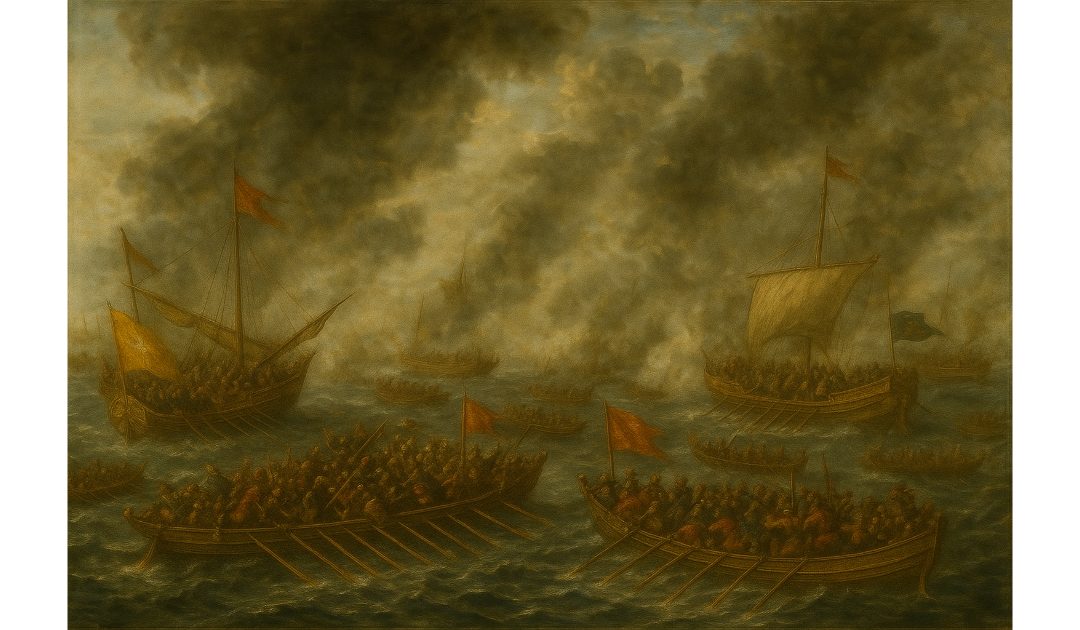The Battle of Lepanto was fought on the 7th of October, 1571. What caught my attention about this battle is that it was the last major naval battle in the Western world to be fought, almost entirely, between galleys, that is to say, rowing vessels. This is only sixteen years before the Spanish Armada, and only six years before Francis Drake set out on his circumnavigation.
The backdrop to Lepanto was the relentless Ottoman expansion across the Mediterranean. Under the command of Sultan Selim II, the Ottomans had steadily increased their influence, culminating in their siege of Cyprus, a Venetian stronghold. The fall of Cyprus alarmed Europe and prompted the formation of the Holy League, led by Don John of Austria, the illegitimate son of Holy Roman Emperor Charles V. Readers of The Spy who Sank the Armada will know that it was John who chased Sir Anthony Standen from Brussels, having caught Anthony, in an inappropriate relationship, with Barbara Von Blomberg, his mother.
The fleets met in the Gulf of Patras, off the coast of western Greece. The Holy League assembled around 206 galleys and six galleasses—large, heavily armed ships—while the Ottoman fleet, commanded by Ali Pasha, boasted approximately 230 galleys and support vessels. Despite the numerical superiority of the Ottomans, the Holy League held technological and tactical advantages, notably the firepower of their galleasses and superior coordination among diverse forces.
On the morning of the battle, the Holy League’s fleet formed a crescent-shaped line, designed to encircle the Ottomans. Don John’s centre squadron faced Ali Pasha’s flagship directly, while the flanks were commanded by seasoned leaders such as Agostino Barbarigo and Giovanni Andrea Doria. The Ottomans mirrored this formation but underestimated the devastating impact of the Holy League’s galleasses, stationed ahead of the main fleet. These ships unleashed a barrage that disrupted the Ottoman advance, sowing chaos among their ranks.
The battle raged fiercely, characterised by brutal hand-to-hand combat as ships collided and soldiers boarded enemy vessels. The Holy League’s right wing, under Doria, managed to outmaneuver the Ottoman left, while on the left flank, Barbarigo fell in battle, but his forces eventually overwhelmed their opponents. In the centre, Don John’s flagship engaged in a fierce duel with Ali Pasha’s vessel. The Holy League’s soldiers boarded the Ottoman flagship after intense fighting, where Ali Pasha was killed, and his head displayed as a symbol of victory.
By late afternoon, the Holy League had secured a decisive victory. The Ottoman fleet suffered catastrophic losses, with around 30,000 men killed, 137 galleys captured, and many others destroyed. In contrast, the Holy League lost about 7,500 men and several ships. One of the most remarkable outcomes was the liberation of over 12,000 Christian slaves who had been rowing in Ottoman galleys.
The Battle of Lepanto’s significance extended beyond the immediate military victory. It was the first major defeat of the Ottoman navy in over a century, halting their dominance in the Mediterranean. Although it did not end Ottoman naval power entirely, it marked the decline of their supremacy at sea and boosted the morale of European states.
Culturally, Lepanto resonated deeply across Europe, celebrated in art, literature, and religious discourse. The victory was attributed to divine intervention, with widespread veneration of the Virgin Mary, leading to the establishment of the Feast of Our Lady of the Rosary on the battle’s anniversary. The renowned Spanish writer Miguel de Cervantes, who fought in the battle and was wounded, later described it as “the greatest event seen by past centuries, present, and future.”

